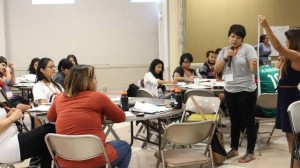Some DREAMers Face Barriers to get GEDs and Qualify for Deferred Action

 By Griselda Nevarez, NewsTaco
By Griselda Nevarez, NewsTaco
Undocumented youth who didn’t complete high school are facing roadblocks to become eligible for the Obama administration’s deferred action program that would allow them to stay and work in the United States.
One of the key requirements of the federal program is having a high school diploma, having a general education development (GED) certificate, being enrolled in school or having served in the military.
Immigrant rights advocates say dreamers who don’t meet any of these requirements are seeking GEDs and are facing barriers along the way.
 They say dreamers are coming across GED testing centers that require them to provide a state-issued identification card. Others are being placed on long waiting lists to enroll in GED-preparation courses. And some are being charged hundreds of dollars to take the preparation courses on top of the up to $110 fee to take the tests.
They say dreamers are coming across GED testing centers that require them to provide a state-issued identification card. Others are being placed on long waiting lists to enroll in GED-preparation courses. And some are being charged hundreds of dollars to take the preparation courses on top of the up to $110 fee to take the tests.
Julieta Garibay, program coordinator of the Dream Educational Empowerment Program (DEEP), said these barriers only exist in several states, especially in those with large numbers of potential deferred action applicants.
The Immigration Policy Center released a new study this week showing that nearly half of the 1.8 million potential beneficiaries live in California and Texas. Other states with large populations include Florida, New York, Illinois and Arizona.
The study also noted that almost a quarter of the 1.8 million don’t have a high school degree or the equivalence of it and must earn a GED to qualify for deferred action.
Deferred Action and the lack of GED preparation programs
Garibay said her group, which is a project of the United We Dream Network, has seen that there aren’t enough available GED preparation programs to serve these dreamers, let along the 35 million people in the U.S. who don’t have a high school diploma.
“There is a huge number of people nationwide who didn’t graduate from high school and a very small number of them who are able to get their GEDs,” Garibay told VOXXI.
Margie McHugh, the Co-Director of the Migration Policy Institute’s National Center on Immigrant Integration Policy, said this problem of not having enough GED preparation programs to meet the demand has existed for “a very long time.”
She said the problem particularly affects the Latino community. That is because Latinos have some of the nation’s highest high school dropout rates, which means that many of them are in need of a GED.
“There hasn’t been as much embrace of those issues by immigrant rights advocates,” McHugh said of the lack of programs that prepare people for the GED. “Hopefully there will be more understanding of it now … because education is the ticket to success in society.”
McHugh also said she has seen significant efforts by immigrant rights organizations to publicize information about the deferred action program. However, she said there are “fairly limited efforts” to publicize places where people can go to get more information about how to earn a GED.
Resources for dreamers seeking GEDs
Garibay pointed out that United We Dream Network provides dreamers with a one-page handout with tips on how to get a GED. They also remind dreamers who dropped out of high school that they can re-enroll and finish if they are under 21 years of age.
She also said more is being done by local immigrant youth led groups to give dreamers information on GED testing in large part because every state has different policies on GEDs.
In Arizona—where a law bans undocumented immigrants from benefiting from free GED preparation courses provided by the state—there are at least three major organizations that are helping dreamers prepare for the GED tests.

Leaders of these organizations say they have seen a surge of dreamers seeking their services ever since Aug. 15, the day the federal government began accepting requests for deferred action.
Friendly House, a nonprofit serving the Latino community in Arizona since 1920, is one of the organizations helping potential deferred action beneficiaries get their GEDs.As of October 10, the U.S. Citizenship and Immigration Services (USCIS) announced it had accepted nearly 180,000 requests for processing; scheduled close to 160,000 appointments to submit fingerprints; and approved the request for deferred action of 4,591 individuals.
Martin Flores, director of strategic development for Friendly House, said the nonprofit charges $350 for 10 weeks of courses designed to prepare for the GED tests, which must be taken at testing centers for a fee of $90.
He said that shortly following the announcement of the deferred action program in June, Friendly House was prepared to help dreamers get their GEDs. That’s because the nonprofit has been providing GED-preparation courses for 20 years and already had the infrastructure in place to help more people.
“It’s in our DNA. It’s part of what we’ve already been doing,” he said of preparing people for the GED tests.
This article was first published in Voxxi.
[Photo by Voxxi/United We Dream]
